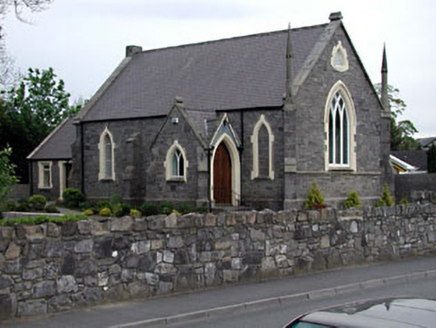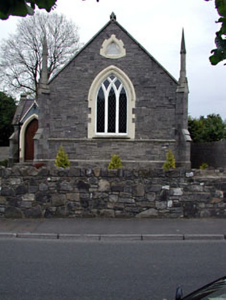Survey Data
Reg No
11805047
Rating
Regional
Categories of Special Interest
Architectural, Historical, Social
Previous Name
Celbridge Wesleyan Chapel
Original Use
Church/chapel
Date
1855 - 1860
Coordinates
297401, 232853
Date Recorded
16/05/2002
Date Updated
--/--/--
Description
Detached three-bay double-height single-cell Methodist church, opened 1859, on a rectangular plan; single-bay single-storey porch (north). Sold, 1948. Adapted to alternative use, 1995. Pitched slate roof with roll moulded ridge tiles, trefoil-topped cut-granite coping to gables, and cast-iron rainwater goods retaining cast-iron downpipes. Repointed broken coursed or snecked limestone walls on cut-granite chamfered cushion course on plinth with diagonal stepped buttresses to corners including cut-granite pinnacle-topped diagonal stepped buttresses to corners (west). Lancet window openings with chamfered sills, and block-and-start surrounds having chamfered reveals framing fixed-pane fittings having lattice glazing bars. Pointed-arch window opening (west) on cut-granite chamfered stringcourse, carved timber interlocking Y-mullions, and block-and-start surround having chamfered reveals with hood moulding framing fixed-pane fittings. Full-height interior with moulded plasterwork cornice below vaulted ceiling. Set in relandscaped grounds.
Appraisal
A church erected to designs by Edward Frederick Tarleton (c.1808-81) of Marlborough Street, Dublin (The Dublin Builder 1st April 1859, 43), representing an important component of the mid nineteenth-century ecclesiastical heritage of Celbridge with the architectural value of the composition, one recalling the later Castledermot Methodist Church (1903; see 11823009), confirmed by such attributes as the compact rectilinear plan form; the construction in a deep grey limestone with silver-grey granite dressings not only demonstrating good quality workmanship, but also producing a sober two-tone palette; the slender profile of the openings underpinning a "medieval" Gothic theme with those openings showing lattice or "quarry" glazing patterns; and the elongated pinnacles embellishing the roof. Having been well maintained, the form and massing survive intact together with substantial quantities of the original fabric, both to the exterior and to the largely featureless interior, thus upholding the character or integrity of a church making a pleasing visual statement in a suburbanised setting.



